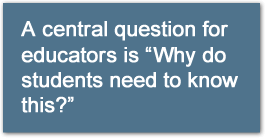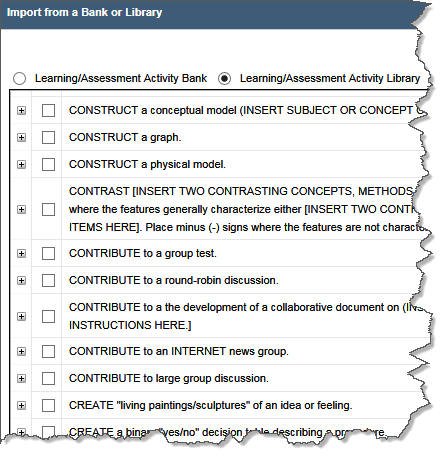WIDS Helps You Ask "Why?"
A common pitfall in curriculum development is writing outcomes that reflect low-level cognitive performance, primarily knowledge and comprehension. However, when instructors are asked to describe what they expect of students in relation to that outcome they often describe performance that reflects a much higher cognitive performance. They want their learners to be able to create, evaluate and analyze.
 WIDS helps instructors write learning outcomes that reflect the high level cognitive performance they expect of their students. By providing libraries of verbs (sorted by Bloom's taxonomy) and performance standards, WIDS software gives instructors support and inspiration for creating higher-level cognitive outcomes. Instructors also use WIDS to write and disseminate assessment tasks, with practical rubrics or checklists. Students can use outcome reports as a self-check or guide in their learning process.
WIDS helps instructors write learning outcomes that reflect the high level cognitive performance they expect of their students. By providing libraries of verbs (sorted by Bloom's taxonomy) and performance standards, WIDS software gives instructors support and inspiration for creating higher-level cognitive outcomes. Instructors also use WIDS to write and disseminate assessment tasks, with practical rubrics or checklists. Students can use outcome reports as a self-check or guide in their learning process.
WIDS professional development workshops encourage instructors to write learning outcomes that incorporate the "why" questions, and to assess the student's ability to ask, research, and formulate answers to these questions. For example, competencies from a philosophy course (below) can encourage questioning and critical thinking. This targets higher-level cognitive performance such as evaluating and applying.

Philosophy Competencies:
- Assess the philosophical base for positions on a variety of personal and societal norms, values, and political structures
- Explain how one’s metaphysical and epistemological framework affects the positions a person takes on a variety of life issues

 The WIDS software framework invites exploration of the “why” questions as instructors develop learning plans and assessments. In fact, one of the main components of a WIDS Learning Plan is the overview, where instructors explain why a particular lesson applies to the learner. Throughout course development in WIDS, instructors are prompted to connect and align outcomes, learning activities and assessments. The WIDS Learning Activity Library provides instructors with a variety of Classroom Assessment Techniques (CATs) to capture student expression of thoughts, questions, and areas of confusion encountered in the classroom. These techniques, supported by WIDS since their conception, are "strongly associated with improved student performance" [Marzano, R. J., Pickering, D. J. & Pollock, J. E. (2001). Classroom instruction that works: Research- based strategies for increasing student achievement. Alexandria, VA: Association for Supervision and Curriculum Development.].
The WIDS software framework invites exploration of the “why” questions as instructors develop learning plans and assessments. In fact, one of the main components of a WIDS Learning Plan is the overview, where instructors explain why a particular lesson applies to the learner. Throughout course development in WIDS, instructors are prompted to connect and align outcomes, learning activities and assessments. The WIDS Learning Activity Library provides instructors with a variety of Classroom Assessment Techniques (CATs) to capture student expression of thoughts, questions, and areas of confusion encountered in the classroom. These techniques, supported by WIDS since their conception, are "strongly associated with improved student performance" [Marzano, R. J., Pickering, D. J. & Pollock, J. E. (2001). Classroom instruction that works: Research- based strategies for increasing student achievement. Alexandria, VA: Association for Supervision and Curriculum Development.].
The competency below and its performance criteria illustrate how instructors can define expectations and leave the learner plenty of room to explore and develop their own ideas and points of view:

Contemporary American Society
Competency: Interpret current trends impacting work and government
Criteria:
• interpretation recognizes characteristics of a trend
• interpretation identifies trends affecting work and government as institutions
• interpretation presents generalizations that encompass the most essential aspects of trends
• interpretation explains generalizations accurately
• interpretation draws conclusions that follow logically from the explanations given
• interpretation is in historical perspective
• interpretation cites information from relevant and reliable sources

Prompting instructors to write learning outcomes and performance standards that reflect student performance they actually expect, gets at the “why” questions. Instructors begin to analyze their own work when writing outcomes. Instructors may realize they are teaching content because of personal preference or tradition, and they begin to ask "why" in fresh new ways. Answering the "why" question can lead to better teaching and better learning -- and that’s the whole point.
This article is an excerpt from a white paper authored by WIDS. Read more about WIDS and Performance-Based Learning.
6193